Six Foods that are Surprisingly High in Toxins
by www.SixWise.com
Certain things automatically come to mind when you think of toxins in your food ... bacteria like e.coli, additives, pesticides, and other contaminants like heavy metals would all certainly apply. But even if your food is completely natural, with no man-made components whatsoever, it may still contain toxins, naturally occurring ones, that is.
|

A carcinogenic mold may be lurking in your peanut butter.
|
The following foods, though generally fine and even healthy when eaten, can cause your harm under certain, surprising, circumstances.
1. Peanuts and peanut butter
Peanuts, you may or may not know, are actually legumes, not nuts, which are grown underground as part of a root system.
It is primarily due to the peanuts' direct contact with the soil that they have become harmful, and even dangerous, to your health.
While actual nuts like almonds and walnuts have strong, hard shells that protect them, the legume known as a peanut has soft and porous skin. When the environment surrounding the peanut becomes warm, humid and wet -- as it does in most regions of the U.S. where peanuts are commonly grown -- a fungal growth occurs.
The fungus itself is not dangerous, but the poison it releases, known as "aflatoxin," is. This cancer-causing agent attacks the liver and is one of the more deadly food-borne toxins in existence.
Good news for the peanut-lovers out there: you can find healthy peanuts, you just need to know what to look for. Namely, choose organic varieties grown in a region where the soil is dry and aflatoxin has therefore not been reported as a problem, such as New Mexico.
2. Potatoes
You may have heard the old adage that green potatoes are poisonous, and indeed they are. All potatoes actually contain low levels of natural toxins called glycoalkaloids. The toxins are produced by the potato in response to stress, which is green potatoes, which have been exposed to UV light, can contain high levels. Potatoes that have a lot of bruising, sprouts or "eyes," or that taste bitter may also have high levels of toxins.
|

Green potatoes really can make you sick.
|
Glycoalkaloids can cause severe stomachache and even death, in rare cases, and it's not destroyed by cooking. You can enjoy potatoes safely by avoiding any sprouts, green or damaged parts, or bitter-tasting portions.
3. Kidney Beans
Eating just four to five raw kidney beans can cause severe stomachache, diarrhea and vomiting because of toxins called lectins. These toxins can also disrupt cellular metabolism. To get rid of the toxin, soak raw beans for at least five hour, then boil them for at least 10 minutes. For you chili lovers, it's not enough to simply throw raw beans in a slow cooker, as cooking them at low temperatures may not destroy the lectin.
|
Got Food Allergies? Get The Food Allergy Survival Guide Book!
 For a complete guide on how to eat if you have food allergies and intolerances, check out the highly recommended Food Allergy Survival Guide Book. In it you'll learn: For a complete guide on how to eat if you have food allergies and intolerances, check out the highly recommended Food Allergy Survival Guide Book. In it you'll learn:
-
How to avoid the foods and ingredients that trigger reactions
-
How to substitute healthful ingredients for those that trigger allergic responses
-
How to meet recommended nutrient intakes while avoiding trigger foods such as dairy products, eggs, gluten-containing grains such as wheat, or other food culprits
-
How to determine which food(s) may be triggers for your symptoms ... and much more!
Find out More About The Food Allergy Survival Guide Book Now!
|
4. Zucchini
If you come across a bitter-tasting or bad-smelling zucchini, don't eat it. This is a sign that it contains a group of natural toxins known as cucurbitacins. Though uncommon in commercially raised zucchini, bitter zucchinis can cause vomiting, stomach cramps, diarrhea and fainting.
5. Bamboo Shoots
A favorite in Asian dishes, there's a reason why bamboo shoots are usually served thinly sliced. By boiling the trimmed and thinly sliced fresh shoots in boiling, salted water, a naturally occurring toxin called cyanogenic glycosides is rendered inert. If you were to eat bamboo shoots raw, you could be exposed to toxic hydrogen cyanide.
6. Parsnips
Parsnips contain natural toxins known as furocoumarins, which are most concentrated in the peel and outermost surface layer, along with any damaged areas. If eaten, furocoumarins can cause stomachache and skin reactions. To reduce the toxin, peel, trim away damaged parts and cook the parsnip before eating it.
Recommended Reading
Food Allergies Last Longer Than They Used To: Food Allergy Facts You Need to Know
How Many Insect Parts and Rodent Hairs are Allowed in Your Food?
Sources
New Zealand Food Safety Authority
World's Healthiest Foods